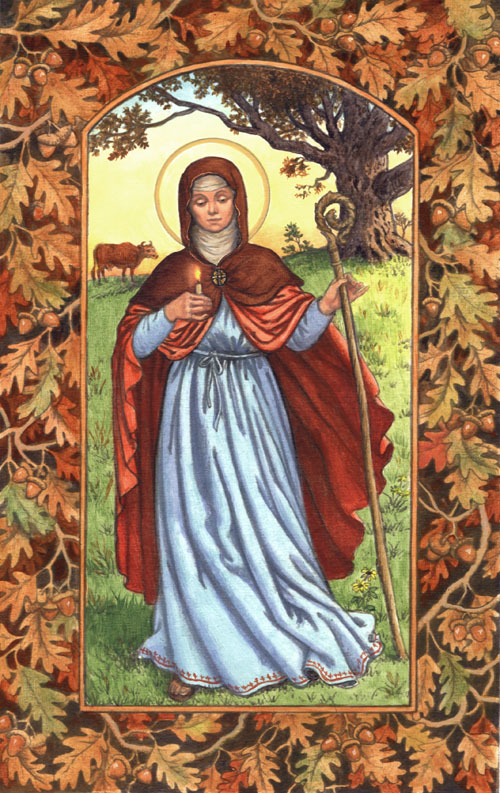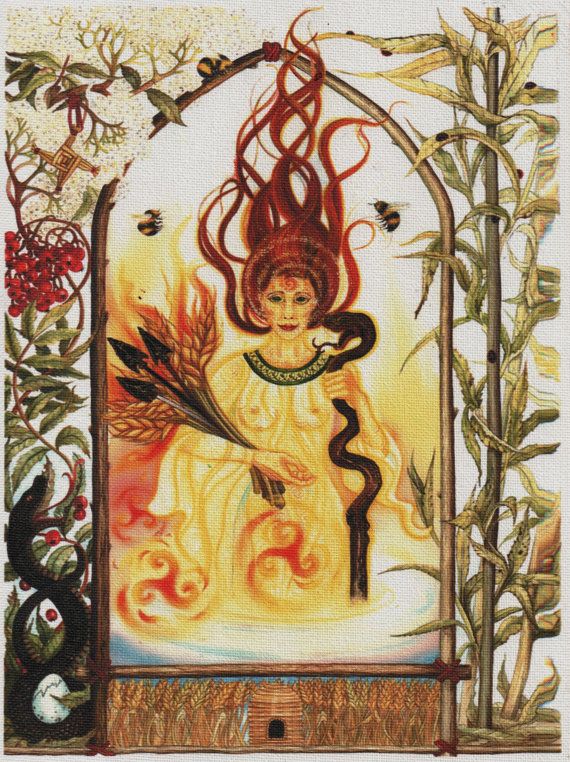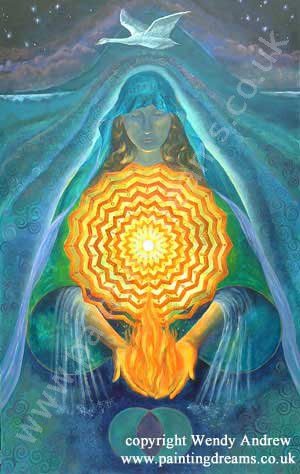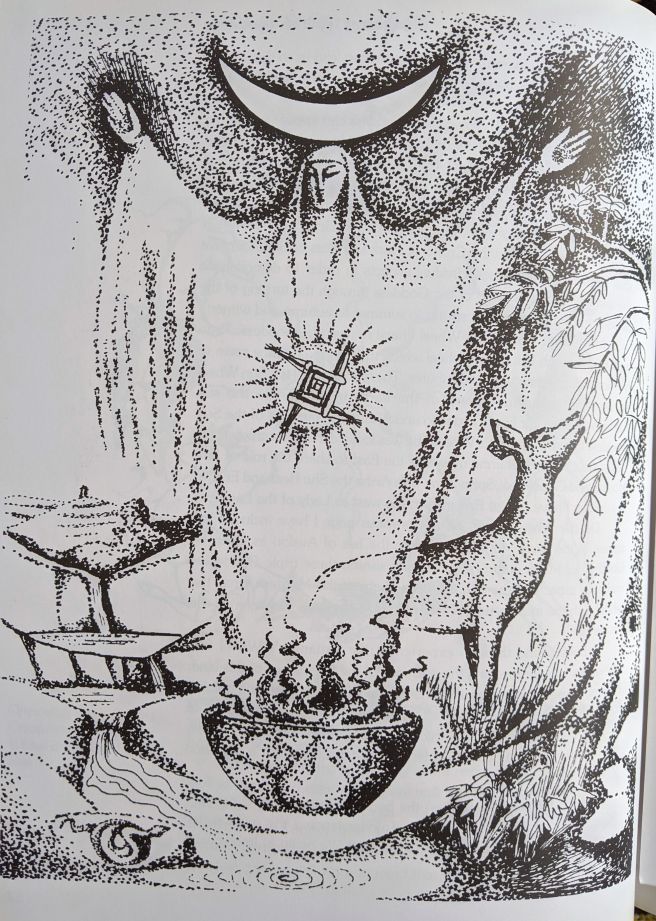Brigid is a much-loved Goddess in Celtic Paganism and Goddess spirituality and some women are devoted to her exclusively. Brigid is a major part of my own Goddess devotion: I have a kitchen shrine to Triple Brigid/ Brigantia where I leave her offerings and light candles to her. I often call on her for inspiration in my creative practices, such as poetry (and blog) writing. My devotions to Brigid become more fervent in mid to late January and continue through much of February, as I concentrate on the Goddess during her time of Imbolc. Where I live, Imbolc very much heralds the beginning of springtime. Don’t get me wrong, she is part of my life during the entire year, but this year’s late winter extending into spring, she seems especially present for me. Brigid at Avalon is a topic I’d been thinking about writing for a while now, and every time Imbolc came I regretted not having done so. Brigid is a Goddess for all seasons and all people. When I finally decided that, yes, I am charging in and writing this topic, I was still hesitant, so I decided to pull a card from The Complete Arthurian Tarot, a deck I haven’t used in quite a while. It is filled with Arthurian characters, places, lore, and just has beautiful art. The card I chose is the Spiral Tower, which depicts Glastonbury Tor. I felt validated in deciding to write about blessed Brigid there. The fact that Brigid has a home in Arthurian lore has strengthened my love of Arthurian/ Avalonian myth and has made me want to make them both a bigger part of my devotional/ witchcraft work.
As an early Christian saint, purported to be born in 453 CE, Brigid is said to have visited Glastonbury to learn from the great centers of learning there, communing at the Chapel of Mary Magdalene, and taught by St. Patrick (a very mythic assertion, as his death date comes close to her birthdate). In Glastonbury, the St. Brigid lore becomes entangled within Arthurian myth. King Arthur is said to have seen a vision of the Virgin at this same Magdalene Chapel and thereafter flew the Virgin’s standard in battle, leaving it victorious. In Celtic Christianity, Brigid is referred to as the “Mary of the Gaels” and as Christ’s “foster-mother.” Perhaps Arthur’s vision was of the Goddess Brigid in her guise of Saint/Virgin? At any rate, there are many reminders of St. Brigid at Glastonbury remaining. The site of the old Chapel of Mary Magdalene has a different chapel dedicated to St. Bride, she is venerated in St. Michael’s church on the Tor, St. Bride’s Mound, and a healing well to her are all testaments to the enduring presence of this Saint and Goddess.

Avalon is a spiritual home for me. One of the reasons I started this blog was to bring to voice how the Arthurian myths and legends inform my spirituality and magical practices. Brigid is a major part of my spirituality and is also part of the Celtic spiritual tradition, which includes that which we term Arthurian or Avalonian. When working with Brigid it is important to remember that “It may be an exercise in futility to try separating the historical Christian Brigid from the goddess since, clearly, the two are so interwoven. …Neither the boundaries of Christianity nor the older belief can contain her exclusively” (Sister Rita Minehan of Solas Bhride). In other words, I cannot speak on the Goddess without speaking of her much-loved Saint form.
The folklore of Glastonbury being the mythical Avalon has been around for centuries now. Literally meaning, “island of apples,” Avalon is a veritable paradise where apple trees grow abundantly without attendance, maidens learn magical arts, and is the final resting place for King Arthur. (I will have many posts on Avalon to come.) Folkloric intersections surround Glastonbury/ Avalon as being the home to early Christian communities, perhaps even founded by Joseph of Arimathea in the first century CE, as well as to pre-Christian Druid centers of learning. As such, modern-day Glastonbury is home to Goddess communities, Arthurian enthusiasts, Druid orders, New Agers, and Christians. Brigid has found a home amongst all these communities because, as the earlier quote attests, she cannot be contained by religious (or folkloric) boundaries.
Part of my devotions to Brigid includes honoring her under the names Brigantia and Bride, as well as Brigid. For me, doing so ties in with the Arthurian sources a little more because these are the British forms of her name; I am not hard and fast with this at all, though. These names share similar Celtic name roots for “high one” and “fiery arrow.” Brigantia was the tribal Goddess for the Brigantes, a Celtic tribe in Britain, and is believed to be the source for the names “Britain” and “Britannia,” a Roman era Goddess in Britain. Modern Goddess priestesses in Glastonbury believe that she is the original sovereign Goddess there, the land is her body, and the Tor is her left breast. The fact that the much-loved Irish saint is purported to have visited, learned, and worshipped at this major site of British spirituality ties her in even more with the Celtic Goddess of the same name. We know that the Celts had Gods of Place but that Brigid is one of those Goddesses who transcended place and tribal lines.
There are few who deny that the saint is based, at least partly, on the Goddess. Perhaps the saint was based on a wonderful abbess who was either already named Brigid, or changed her name to it, so as to align herself with those who loved the Goddess. Many of the attributes that we give to the Goddess are in fact taken directly from the hagiography (sacred biography of saints) of St. Brigid. Hagiographies were written to align that saint, even more than when they were living, with Christ and his attributes. Perhaps St. Brigid was created whole cloth in the sixth century by hagiographers; it doesn’t matter because people’s devotion is true. Some of her miracles include turning water into beer, preserving her virginity by plucking out her eye so as to deter suitors and then restoring her vision, healing and midwifery, hanging her cloak to dry on a sunbeam, making cows give prolific amounts of milk, and creating a proliferation of honey. These attributes were also attractive to contemporary Celts who would have heard these stories about the Saint and been familiar with the themes of generosity and healing, as they were highly valued in Celtic society. Healing, the sun, poetry and inspiration, and smith craft are the purview of the Goddess, but are certainly comfortable attributes of the Saint. The saint with the attributes of a Goddess and the Goddess with the attributes of the saint is the one who is believed to have visited Glastonbury and has since become a staple part of the Goddess community there.

Brigid is especially worshipped at the time of her Sabbat, Imbolc or Oimelc, and the saint’s feast day, Candlemas, both February 1 or 2. Brigid is the Goddess I honor at this point of the Wheel. I also consider Imbolc to be the beginning of my devotional year, because it so spring like for me then, it is soon after the actual New Year, and includes themes like renewal and purification. Writing this post has helped me to align these aspects of my Witchcraft and devotional journeys together. Brigid, Goddess and Saint, is a major part of my life. I am happy to find her intersecting with the land of Avalon.
Brigid at Avalon, a poem
She prayed to the Magdalene
At her Chapel near the Tor.
Bright Woman of no sin,
What is it you pray for?
Do you pray for the summer sun
To never dim or fade?
Do you pray for the faerie folk
Who run in the magic glade?
Goddess, Woman, Saint
Bright Woman of flame and well
Stir you cauldron, weave your spell
You were born on a threshold,
Neither in nor out.
You dried your cloak on a sunbeam.
You sang to the little trout.
You heal the ill,
Restore the blind’s sight,
Come to me at Brigid’s Hill.
Come, Goddess of the light.
Goddess, Woman, Saint
Bright Woman of flame and well
Stir you cauldron, weave your spell
*
I’d like to leave you with these creative offerings from women of Glastonbury/ Avalon.




Brigit, Bridie, Bringer of Light
Kele-Keeper of the original sight
Nineteen Maidens tend your hearth
Goddess of healing and smithcraft
Bride of the White Hills
Bride of the Golden Hair
Bride of the Sun and Moon
Mary of the Gael
Blessed poetry spoken by the well
Brigit of healing with a magical spell
She is the White Swan, wings outspread
Flying southwest, dreaming ahead
Serpent Bridie, hidden in the earth
Cow Mother Brigit giving of your wealth
Wolf Clan Woman teach us what we need
The touch of your wand quickening the seeds
Dakini Woman, illuminate our Sight
Rattle your drum that rolls in the night
Snowdrop Queen, sacred Milk Maid
Give to us your fecundating flame
~Kathy Jones, from The Ancient British Goddess
Bibliography and Recommended Reading
*Hayley Arrington:
my thesis, linked on the blog “Celtic Solar Goddesses: From Goddess of the Sun to Queen of Heaven”
*Marion Bowman:
“Arthur and Bridget in Avalon: Celtic Myth, Vernacular Religion, and Contemporary Spirituality in Glastonbury”
*Courtney Davis and Elaine Gill:
The Celtic Saints
*Kathy Jones:
The Ancient British Goddess
*Caitlín Matthews:
The Elements of The Celtic Tradition
*Catitlín and John Matthews:
The Complete Arthurian Tarot
Ladies of the Lake
*Lunaea Weatherstone:
Tending Brigid’s Flame
websites:
Avalon Journey
https://avalonjourney.com/brigid/
The Glastonbury Shrine
http://www.glastonburyshrine.co.uk/Shrine/StBrigid.php
Wendy Andrew:
https://www.paintingdreams.co.uk/
Glastonbury-based shop:
https://goddesstemplegifts.co.uk/
